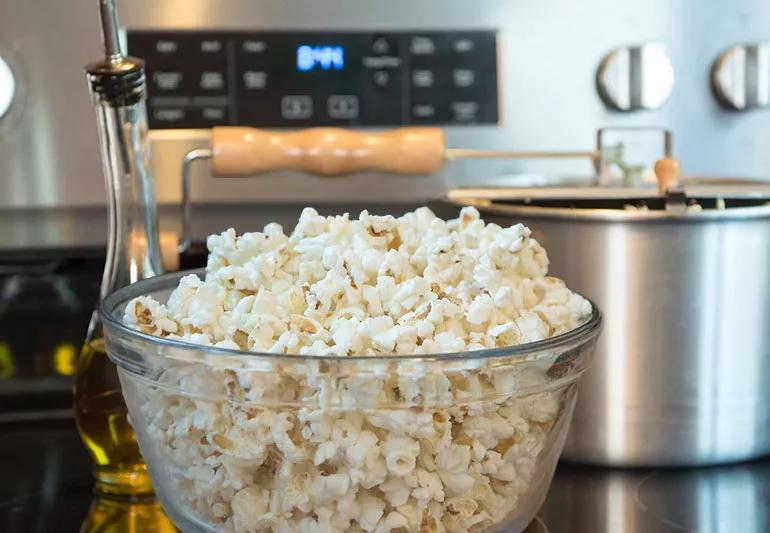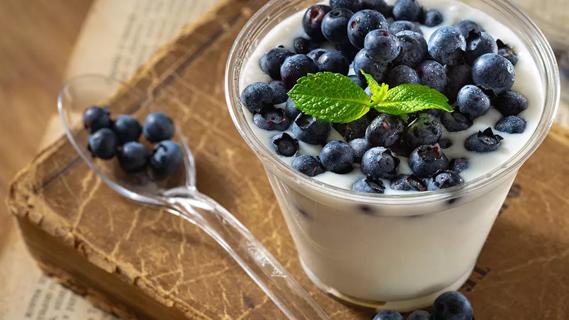This crunchy, delicious treat doesn't have to be unhealthy

A classic favorite, the health benefits of popcorn may surprise you. It’s higher in antioxidants than many fruits and vegetables, it’s a good source of fiber and it’s a whole grain. What more can you want from America’s favorite snack?
Advertisement
Cleveland Clinic is a non-profit academic medical center. Advertising on our site helps support our mission. We do not endorse non-Cleveland Clinic products or services. Policy
On the flipside, popcorn is often coated with butter, salt, sugar and hidden chemicals. Even when you avoid the obvious dietary pitfalls and empty calories, there are questions that arise about the best, healthiest ways to cook and prepare it.
We asked registered dietitian Laura Jeffers, MEd, RD, LD nine tips to help you make the most of this crunchy treat:
Air popped popcorn uses no oil, meaning it has the fewest calories.
“Popping it in oil, however, is a great way to consume a healthy portion of fat to control hunger,” Jeffers says.
Not only can you manage serving size, but you can also make it in under 10 minutes in most cases. All you need is a pot, lid and oil and you’ll be on your way to making healthy popcorn.
Walnut, avocado or extra virgin olive oils are best when making popcorn on the stovetop. Canola oil is the next best option. Flaxseed and wheat germ oil shouldn’t be heated, so they don’t really work for popping popcorn. Use palm and coconut oils sparingly because of their high saturated fat content and avoid corn, sunflower and soybean oils altogether.
A serving size depends on the type of popcorn you are eating, but for reference, one cup of plain popcorn is about 30 calories. Be cautious because once you start adding toppings, the calorie count goes up pretty quickly.
Advertisement
In general, microwave popcorn is the least healthy option. It often contains a lot of salt, the flavorings are artificial and people tend to eat too much because of the large portion size of most bags.
Buttered popcorn is a fan favorite but unfortunately comes with hidden chemicals and calories.
If you feel like you must have it, use 2 to 3 teaspoons and gradually cut it out altogether. When you purchase buttered or extra buttered popcorn at a movie theater, a chemical is added to the food. If you add extra butter, you are getting at least one and a half times the normal butter serving. But, if you are eating movie theater popcorn and adding butter, the damage is probably already done.
“If it is a very infrequent treat and you order a small size, I don’t think it makes that much of a difference,” Jeffers says.
Kettle corn is usually mixed with refined sugar, salt and oil and is a slightly less nutritious option because it increases calories and salt intake. Most people should only get 2,300 mg of sodium each day, which is about one teaspoon. When kettle corn is prepackaged, it’s even harder to control the sodium and calories. It’s best to opt for low-sodium versions when possible, Jeffers says.
Avoid purchasing popcorn that is anything more than your basic popped kernel because with each thing added, the food becomes less healthy. Although we crave sweets at times, beware of sweet popcorn because it comes from artificial sweeteners.
“View prepackaged varieties like caramel or dark chocolate as a treat, not a healthy snack,” Jeffers says.
Be aware that things like truffle oil and cheese powders aren’t usually made from truffles or cheese, but from chemical and artificial flavorings. Make sure to read labels whenever you’re at the grocery store to really understand what ingredients are in the box.
Spice up your popcorn in a healthy way by adding hot sauce or melt a couple of ounces of cheese on your popcorn. You also can try a sprinkle of balsamic vinegar or eat your popcorn with pickles or jalapeño peppers. Make sure to add spices and seasonings and not powders, flavorings or a lot of salt.
One way to keep popcorn servings under control and make you feel fuller longer is to pair it with a protein. Try eating it with a tablespoon of peanut butter, 2 ounces of cheese (as long as you didn’t top the popcorn with cheese already) or another protein source you like. You’ll be on your way to eating a nutritious snack in no time!
Advertisement
Learn more about our editorial process.
Advertisement

This color additive, found in many pre-packaged foods, may affect people with ADHD or allergies

This decadent treat may help improve your heart health and boost your mood

With a little planning, you can fill your belly and boost your energy

Snacking can bring benefits with healthy food choices and planning

Plan ahead, bring a cooler when possible and don’t forget the water!

These foods sabotage weight loss and rob you of rest

A closer look at what's inside your favorite candy

These foods will nourish your body without ruining your diet

The best parenting style balances enforcing rules and showing plenty of love

Tips include cutting back on sugar, focusing on exercise and managing stress

It can be harder to let go when you’ve invested time, energy and emotions — but it might be the healthier choice long term